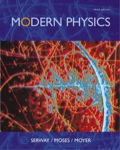
(a)
The distance from A of the impact points of molecules.
(a)
Answer to Problem 3P
The distance covered by molecules travelling at
Explanation of Solution
The molecule covers d distance in t time with the speed of v.
Write the expression for
Here,
Substitute
Here, d is the diameter of cylinder and v is the velocity of molecule.
Write the expression for distance covered.
Here, s is the distance covered.
Substitute
Write the expression for average velocity.
Here, m is the mass of gas molecule,
Write the expression for root mean square velocity.
Here,
Write the expression for most probable velocity.
Here,
Conclusion:
Substitute
Substitute
Substitute
Substitute 6250 for N,
Substitute 6250 for N,
Substitute 6250 for N,
Thus, the distance covered by molecules travelling at
(b)
The reason why
(b)
Answer to Problem 3P
The molecules of
Explanation of Solution
The momentum of
Conclusion:
Thus, the molecules of
Want to see more full solutions like this?
Chapter 10 Solutions
EBK MODERN PHYSICS
- What is the energy density U/V of a photon gas at (a) room temperature (T = 295 K), and (b) at a temperature 50 times larger? (a) The energy density U/V of a photon gas at room temperature (T = 295 K) is _______Jm3 (b) The energy density U/V of a photon gas at a temperature 50 times larger than the room temperature is_______ Jm3arrow_forwardGiven Maxwell-Boltzmann distribution f(v) derive energy distribution F(E), where E=mv^2/2.arrow_forwardShow that heat is a path function.arrow_forward
- A tungsten filament of a typical incandescent lightbulb operates at a temperature near 3000 K. At what wavelength is the intensity at its maximum?arrow_forwardIn terms of the length of an air column, what is the longest standing wavelength that can exist in an air column that is (a) closed at one end? (b) open at both ends?arrow_forwardThe temperature of the filament of an incandescent lightbulb is 2500 K. Assuming the filament to be a blackbody, determine the fraction of the radiant energy emitted by the filament that falls in the visible range. Also, determine the wavelength at which the emission of radiation from the filament peaks.arrow_forward
- UPVOTE WILL BE GIVEN! PLEASE WRITE THE SOLUTIONS COMPLETELY AND LEGIBLY. PLEASE ANSWER #2 1. Calculate the sabins of absorption at 1000 Hz in a room that has dimensions of 11.00m wide x 15.00m long x 3.50m high. The room has: a. Plasterboard (12mm(1/2") in suspended ceiling grid b. Walls are constructed of concrete blocks (coarse). c. The floor is covered with marble. 2. The absorption coefficients of the materials at 1000Hz are as follows: a. Plasterboard (12mm(1/2") in suspended ceiling grid – 0.04 b. Concrete blocks (coarse) - 0.29 c. Marble flooring -0.01 3. Compute the reverberation time (RT60) of the room. 4. Is the reverberation time appropriate for a room designed for speech? 5. As a designer, what will you recommend 5 to increase (or decrease) the reverberation time?arrow_forwardIs this a maxwell- boltzman distriubtion curve?arrow_forwardA particular star has a radius of 8.46 ✕ 108 m. The peak intensity of the radiation it emits is at a wavelength of 679 nm. (a) What is the energy (in J) of a photon with this wavelength? answer in J (b) What is the star's surface temperature (in K)? (Round your answer to at least the nearest integer.) answer in K (c) At what rate (in W) is energy emitted from the star in the form of radiation? Assume the star is a blackbody, with emissivity e = 1. answer in W (d) Using the results from parts (a) and (c), estimate the rate (in photons/s) at which photons are emitted by the star. answer in photon/sarrow_forward
 Modern PhysicsPhysicsISBN:9781111794378Author:Raymond A. Serway, Clement J. Moses, Curt A. MoyerPublisher:Cengage Learning
Modern PhysicsPhysicsISBN:9781111794378Author:Raymond A. Serway, Clement J. Moses, Curt A. MoyerPublisher:Cengage Learning Physics for Scientists and Engineers with Modern ...PhysicsISBN:9781337553292Author:Raymond A. Serway, John W. JewettPublisher:Cengage Learning
Physics for Scientists and Engineers with Modern ...PhysicsISBN:9781337553292Author:Raymond A. Serway, John W. JewettPublisher:Cengage Learning Principles of Physics: A Calculus-Based TextPhysicsISBN:9781133104261Author:Raymond A. Serway, John W. JewettPublisher:Cengage Learning
Principles of Physics: A Calculus-Based TextPhysicsISBN:9781133104261Author:Raymond A. Serway, John W. JewettPublisher:Cengage Learning


